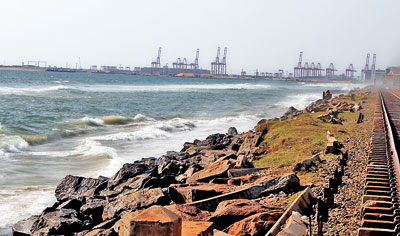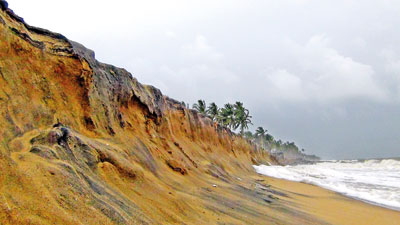News
Famed beaches could disappear
Illegal sandmining and construction work in the coastal zone are increasing the speed by which our sandy beaches are being swallowed by the sea.

Contrary to public opinion, the construction of the Colombo Port City itself does not threaten severe coastal erosion. Pic by Priyanka Samaraweera
Coastal erosion is sometimes inevitable, occurring when the transportation of sand from riverbeds to the sea is disrupted due to wither natural or human-influenced factors.
Sea-level rises, global warming wave patterns, storms, currents, tides, wind-driven water and waterborne ice all contribute to the slow loss of coastal land, but this loss of land eventually evens out despite an altered coastline.
However, it is the haphazard construction and development in Sri Lanka that raises alarm as it speeds up the process of erosion, resulting in damage to the fisheries and tourism industries, choking people’s livelihood, and damaging houses in the region.
According to statistics from the Department of Coast Conservation and Coastal Resource Management, annual permits for 11 million cubic metres of sandmining are issued but Sri Lanka’s construction industry uses more than 20 million cubic metres of sand. An official from the department said that around nine million cubic metres are mined illegally per year.
“This figure is based on recorded data but the actual figure could be much higher,” said Chief Engineer (Coastal Development), R.A.S. Ranawaka.
“When such a large quantity is mined from riverbeds, it distorts the sand-flow to the sea. This disruption causes a shortage of sand on the beaches, and this is coastal erosion,” he said.
The Director-General of Coast Conservation, Prabath Chandrakeerthi, said the the threat is most serious in the Puttalam District, with Marawila and Thoduwa being the worst areas. Other areas severely affected are the Calido and Tangerine beaches in Kalutara and the beach adjacent to the Oluvil Harbour.

Illegal sand mining destroying beaches in the Puttalam district. Pic by Hiran Priyankara Jayasinghe
The breakwater constructed for the Oluvil Harbour has diverted sand-flow with the harbour receiving sand at the cost of other beaches in the vicinity, Mr. Chandrakeerthi said.
Mr. Ranawaka explained how the breakwater had led to a sandbar being created at the mouth of the harbour that rendered the harbour unusable.
“With a 1.5 km sandbar forming at the mouth of the harbour, there was a lack of sand on the northern side of the port, and this has now spread for 9km northwards,” he stated. “The responsibility lies with the Ports Authority as it is their duty to conduct feasibility studies before commencing construction.”
The commercialisation of Colombo has seen the city lose most of its beaches. Mr. Ranawaka cited the Kollupitiya to Bambalapitiya beach stretch as an example of how the Department had to opt for a revetment to mitigate erosion, at the cost of the beach disappearing.
“When this was done more than 30 years ago, funds allocated for environment protection were limited so we had to choose the revetment strategy. The main priority was to safeguard the railway line. Hence, a revetment using rocks was constructed along the beach,” he said.
Revetments, along with breakwaters and groynes are considered “hard solutions” (one that policy-makers resort to as a last option when the threat of erosion is severe). Sand nourishment and the measures taken to revitalise coral life are soft solutions and are environment-friendly, the official explained.
Sand nourishment is carried out at a number of beaches where it is assessed that the situation can be mitigated in such ways. In 2017, a sand nourishment project was undertaken for the beach in Marawila following the government’s decision to allocate Rs. 800 million for coast conservation activities. A similar project was carried out at Unawatuna in 2015.
Another factor in erosion which has been plaguing the Coast Conservation Department (CCD) for some time is the illegal construction of beach-side restaurants, houses and hotels.
Permits to construct any structure in the coastal zone must be obtained solely from the CCD. Mr. Chandrakeerthi said that the current act was tough as it allowed the police to arrest owners guilty of constructions in the coastal zone without a permit.
The coastal zone is calculated from the permanent vegetation line along beaches to anywhere between 10-300m landwards, depending on the beach.
“Last year, with the help of the police, we were able to crack down on many such establishments in the Mirissa region and we are pursuing the same policy now,” Mr. Chandrakeerthi said.
In most instances the culprits were small and medium-sized establishments. “Bigger businesses follow a public relations campaign based on environmentally friendly practices, so they avoid any activity that could stain their reputation,” Mr. Chandrakeerthi said.
Contrary to public opinion, the construction of the Colombo Port City itself does not threaten severe coastal erosion, Mr. Ranawaka explained. This was because the existing south harbour breakwater has the port city covered, and so any erosion that might occur would be due to the breakwater and not the port city.
He said that even if the port city was not being constructed, sand would have accumulated at the site naturally as the breakwater had altered the sand transportation pattern. This sand deposit will come at the cost of a shortage of sand to other areas in the region.
Sand used to build the port city foundations came from offshore Negombo and in return the port city developers were required to build up sand at Negombo Beach, and they have done so, he said.
The CCD allows offshore mining, provided it is mined 3km offshore and from a depth of more than 15m. Dr. Terney Pradeep Kumara, General Manager of the Marine Environment Protection Authority (MEPA), said increasing coastal erosion damaged biodiversity and the economy.
“The loss of beaches and biodiversity in the coastal zone reduces tourist attractions and this could have a long-term economic impact too,” he said. “Our economy is based on the environment and destroying the environment will damage the economy.

